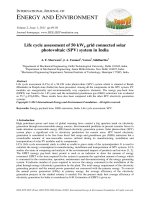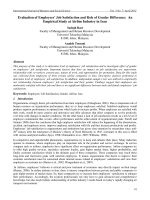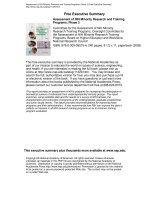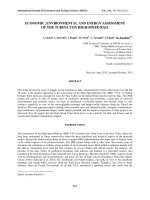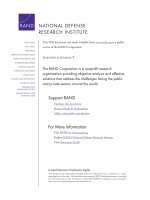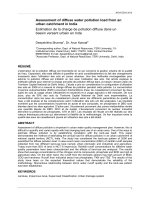Assessment of physicochemical and microbiological quality of Nagpuri buffalo raw milk collected at different areas in Nagpur city
Bạn đang xem bản rút gọn của tài liệu. Xem và tải ngay bản đầy đủ của tài liệu tại đây (495.6 KB, 6 trang )
Int.J.Curr.Microbiol.App.Sci (2019) 8(2): 2744-2749
International Journal of Current Microbiology and Applied Sciences
ISSN: 2319-7706 Volume 8 Number 02 (2019)
Journal homepage:
Original Research Article
/>
Assessment of Physicochemical and Microbiological Quality of Nagpuri
Buffalo Raw Milk Collected at Different Areas in Nagpur City
L.D. Dhote1*, G.J. Bidgar2, N.R. Pansare2, K. Satyaprakash2, S.V. Shinde2,
S.P. Chaudhary2, A.R. Patil3 and W.A. Khan3
Department of Veterinary Public Health and Epidemiology, Nagpur Veterinary College,
Seminaryhills, Nagpur-440006, India
*Corresponding author
ABSTRACT
Keywords
Nagpuri Buffaloes,
Vendors, Physiochemical,
Bacteriological
commercial kit,
Food-borne
Article Info
Accepted:
20 January 2019
Available Online:
10 February 2019
Nagpuri buffalo is native to Nagpur region of Maharashtra.The Nagpuri buffaloes are
moderately good milk producers. Their milk is of very good quality containing around 7.7
percent of fat. Most of the people especially children depend on local vendors for buffalo
milk. Alteration in physicochemical /microbiological parameters has direct impact on the
quality of milk. Growing evidence those foods borne pathogen directly or indirectly causes
or predispose man to chronic diseases. The present study is conducted to analyze the
physiochemical and microbiological quality of raw milk by employing clot on boiling test,
California mastitis test, titrable acidity, methylene blue reduction test and again the same
sample were processed for identification of differential food borne pathogen by using
Himedia differential food borne pathogen commercial kit. A total of 40 different Nagpuri
buffalo milk samples were collected from different areas in Nagpur city. Sample collected
directly into the sterilized milk collection bottle and subjected to analysis in the laboratory.
Out of 40 samples buffalo milk, 22 samples (55 per cent) shown titrable acidity more than
0.18% and five (12.5 per cent) with CMT positivity. The COB and MBRT turned negative
for all the samples tested and. Total viable count is under acceptable range. By using
bacteriological commercial kit, Out of total 40 samples, seven samples became positive for
E. coli (17.5%), one for Salmonella (2.5%), one for Vibrio (2.5%), nine for Listeria
monocytogenes (22.5%) and two for Staphylococcus aureus (5%). In conclusion, from the
above result it is concluded that the presence of pathogens in milk samples is the matter of
concern from public health point of view. Further, the bacterial contamination may be
contributed to less hygienic practices followed with respect to udder health management.
Introduction
India stands 1st in the world for milk
production as well as buffalo population.
India continues the largest producer of milk in
world by producing 165.4MT in 2016-2017
statistics of India. The per capita availability
of the milk is 355gm/day and ICMR
recommendation is 280gm/day in our country.
This indicates the growth in availability of
milk and milk product for every year.
(Department of Animal Husbandry, Dairying
2744
Int.J.Curr.Microbiol.App.Sci (2019) 8(2): 2744-2749
& Fisheries, Ministry of Agriculture, GoI
2016-2017).
Milk act as rejuvenator, has health protecting
and promoting properties, hence can be
referred as one of the best vitalisers and it is
considered the most important part of our
diet. But the greatest drawback it is perishable
in nature which is responsible for the spoilage
of raw milk because of that its shelf life
become very less at room temperature.
Number of factors are responsible, to change
in the quality of milk some of the most
important causes are: health of the animal,
housing, sanitation along with the person
involved in the production, their health,
sanitary practices followed by them and
finally the container in which milk is poured
which is invariably contaminating and last but
not the least tropical nature of climate of our
country (Nalwaya et al., 2018). The Nagpuri
buffalo is a very good breed of water buffalo
from India. It is actually from Maharashtra,
and it stands better amongst the buffalo
breeds which combine the milk and drought
qualities in a better proportion in adverse
climatic conditions. The Nagpuri buffaloes
are moderately good milk producers. As the
name suggests, it is a versatile breed of the
Vidarbha region (central Indian breed) of
Maharashtra. They are very well adapted to
the harsh-semi-arid conditions of Vidarbha
region. The Nagpuri buffaloes are very good
for milk production. Their average lactation
period is around 286 days. And on an
average, they produce minimum 1055 liters of
milk per lactation. Their milk is of very good
quality containing around 7.7 percent of fat.
Most of the people especially children depend
on local vendors for buffalo milk. Alteration
in
physicochemical
/microbiological
parameters has direct impact on the quality of
milk. Growing evidence those foods borne
pathogen directly or indirectly causes or
predispose man to chronic diseases. As in any
raw milk, microorganisms can multiply
rapidly in buffalo milk due to its high nutrient
content.
Previous
studies
on
the
microbiological quality of buffalo milk have
revealed the presence of, e.g., coliform
bacteria, Escherichia coli, lactic acid
bacteria, Listeria monocytogenes, yeasts,
moulds, Staphylococcus spp. and Clostridium
spp. The occurrence of highly pathogenic
spoilage producing bacteria might lead to the
deterioration of buffalo milk and present a
public health hazard (Han et al., 2007)
Materials and Methods
Sample collection
A total of 40 different Nagpuri buffalo milk
samples were collected aseptically from the
udder directly into sterilized milk sampling
bottles from the different areas in Nagpur
city.
Physiochemical
analysis
and
microbiological
The samples were analysed for clot on boiling
test, MBRT, titrable acidity, CMT and
microbiological quality test ie. Total Viable
Count (TVC)
Microbiological analysis with commercial
kit
These samples were processed as per the
guidelines in the manual of commercial kit
(HiMedia) and were tested for the presence of
important food-borne pathogens like E. coli,
Salmonella, E. coli O157:H7, Vibrio,
Staphylococcus
aureus,
Listeria
monocytogens and Clostridium organisms.
Results and Discussion
Present study was carried out to determine
physico-chemical
and
microbiological
2745
Int.J.Curr.Microbiol.App.Sci (2019) 8(2): 2744-2749
qualities of milk. The wrong milking
practices, polluted water supply, defective
transport,
warm
climate,
unhygienic
conditions of farms, the lack of suitable
technical and educational information causes
inferior quality of milk and indigenous milk
products especially in unorganized sector
these are the main reasons for deterioration of
raw milk very early. By knowing the
importance of milk in human diet, Nagpuri
buffalo raw milk samples were collected to
assess
the
physico-chemical
and
microbiological qualities of milk sold in the
unorganized sector of Nagpur city. The results
obtained were analyzed using appropriate
method and presented as follows (Fig. 1–3).
Physicochemical analysis
Acidity in milk have been measured in terms
of per cent lactic acid, in different samples of
milk is ranged from 0.13 to 0.28 (per cent of
Lactic acid bacteria) (Table 1).
Table.1 Physico-chemical and microbiological analysis of milk sample
Sample
collected
40
Titrable
acidity
22
Acidity more
than 0.18%
California
test
5
Positive
mastitis Clot on boiling
Negative
Methylene blue
reduction test
Negative
Table.2 Microbiological analysis of milk sample by using differential food borne pathogen
commercial kit (Himedia)
organism
E. coli
Salmonella
Vibrio
L.monocytogenes
staphylococcus
Total
No of positive
7
1
1
9
2
20
Percentage
17.5
2.5
2.5
22.5
5
50
Fig.1&2 CMT using strip cup & Plate showing colonies at 10-⁴ dilution
2746
Int.J.Curr.Microbiol.App.Sci (2019) 8(2): 2744-2749
Fig.3
Detection of Listeria
Listeria on PALCAM
Detection of E. coli
E. coli on EMB agar
PREVALENCE PERCENTAGE
E. coli
17%
Negative
50%
S.aureus
5%
2747
Salmonella
2%
Vibrio
3%
Listeria
23%
Int.J.Curr.Microbiol.App.Sci (2019) 8(2): 2744-2749
Acidity of milk samples showed significant
variation. California mastitis test have been
tested by using California mastitis reagent,
out of 40 samples 5 samples were positive for
CMT test. The total viable count it is under
acceptable range. All the samples were
negative for the clot on boiling test and
methylene blue reduction test. The
physiochemical analysis of the milk sample
was shown a good relation among MBRT and
total viable count. The total viable count
determines the microbial load in a sample
which develops due to various reasons like
contamination of utensils, adulteration of milk
with polluted water, milk obtained from
diseased cows (mastitis milk). The time taken
for the reduction of the dye is influenced by
the number and type of bacteria growing in
milk and the greater the activity more rapidly
the dye reduced. The methylene blue acts as
an indicator of bacterial number and activity
in raw milk. The sample shown dye reduction
time more than 5 hr it means it is the good
quality of milk. Positivity for CMT indicates
the increase somatic cell count in milk sample
it may be because of any disease condition or
due to the unhygienic condition at farm level.
Microbiological analysis
All 40 samples were process for identification
different food borne pathogen. The
procedures for detection of different food
borne are given in the prescribed manual
along with the Himedia differential food
borne pathogen commercial kit. The entire
sample was examined for the E. coli,
Salmonella, Vibrio, E. coli O157:H7, Listeria
monocytogenes, Staphylococcus aureus, and
Clostridium spp. Out of all the 40 samples
processed for identification of differential
food borne pathogen 20 (50%) samples were
shown positivity for E. coli (7), Salmonella
(1), Vibrio (1), Listeria monocytogenes (9),
and Staphylococcus aureus (2) suggesting that
it could be due to contaminated environment
and unhygienic handling or preparation
(Table 2). From the above result it is
concluded that, a good correlation among
MBRT and TVC techniques was observed.
The possibility of sources other than
microbial sources for mastitis cannot be
denied in these cases. the presence of
pathogens in milk samples is the matter of
concern from public health point of view.
Further, the bacterial contamination may be
contributed to less hygienic practices
followed with respect to udder health
management.
Acknowledgement
The authors gratefully thank the Department
of veterinary public health and epidemiology,
Nagpur for technical and financial support of
this study.
References
Deb, M. and Seth, D. (2014).Studies on the
Physico-Chemical and Microbiological
Analysis of Plain Dahi of Assam
(India).
Journal
of
Bioresource
Engineering and Technology | Year2014 1: 27-32.
Fadaei, A. (2014). Bacteriological quality of
raw cow milk in Shahrekord, Iran.
Veterinary World. 7(4): 240-243.
FSSAI (2011). Food Safety and Standard
Authority of India. Ministry of Health
and Family Welfare, published in The
Gazette of India.
Han, B., Meng, Y., Li, M., Yang, Y., Ren, F.,
Zeng, Q., Robert-nout, M.J. (2007). A
survey on the microbiological and
chemical composition of buffalo milk in
china. food control 18(2007) 742-746.
Hossain, M. B. and Dev, S. R. (2013).
Physiochemical
Characteristics
of
Various Raw Milk Samples in a
Selected Dairy Plant of Bangladesh.
International Journal of Engineering and
2748
Int.J.Curr.Microbiol.App.Sci (2019) 8(2): 2744-2749
Applied Sciences.1 (3): 91-96.
Jain, N. and Shrivastava, S. (2014). Quality
Assurance of Marketed Raw Milk in
Bhopal city, MP, India. International
Research
Journal
of
Biological
Sciences. 3(11): 23-27
Nalwaya, S.B., Prajapati, B.I., Bariya, A.R.,
Goswami, M.M. and Roy, S.K.,2018.
Evaluation of Physico-Chemical and
Microbiological Quality of Milk of
Banaskantha
District,
India.
Int.J.Curr.Microbiol.App.Sci
(2018)
7(12): 1635-1641
Rajeev, K. and Amit, P. (2010). Detection of
E. coli and Staphylococcus in Milk and
Milk Products in and around Pantnagar.
Veterinary World, 2010, Vol.3(11):49549
Ramya, P., Babu, A. J., Reddy, E. T., Reddy,
Y. R. and Rao, L. V. (2016). Analysis
of various physico chemical properties
of raw buffalo milk samples marketed
in and around Proddatur town, YSR
Kadapa district, Andhra Pradesh, India.
Journal of Livestock Science. 7: 30-3
Singh, A. and Pratap, A. (2014). Comparison
of Physicochemical Properties of Raw
Milk from Indigenous and Exotic Cows
at Allahabad. International Journal of
Science and Research.3 (8): 1566-156.
How to cite this article:
Dhote, L.D., G.J. Bidgar, N.R. Pansare, K. Satyaprakash, S.V. Shinde, S.P. Chaudhary, A.R.
Patil and Khan, W.A. 2019. Assessment of Physicochemical and Microbiological Quality of
Nagpuri Buffalo Raw Milk Collected at Different Areas in Nagpur City.
Int.J.Curr.Microbiol.App.Sci. 8(02): 2744-2749. doi: />
2749
